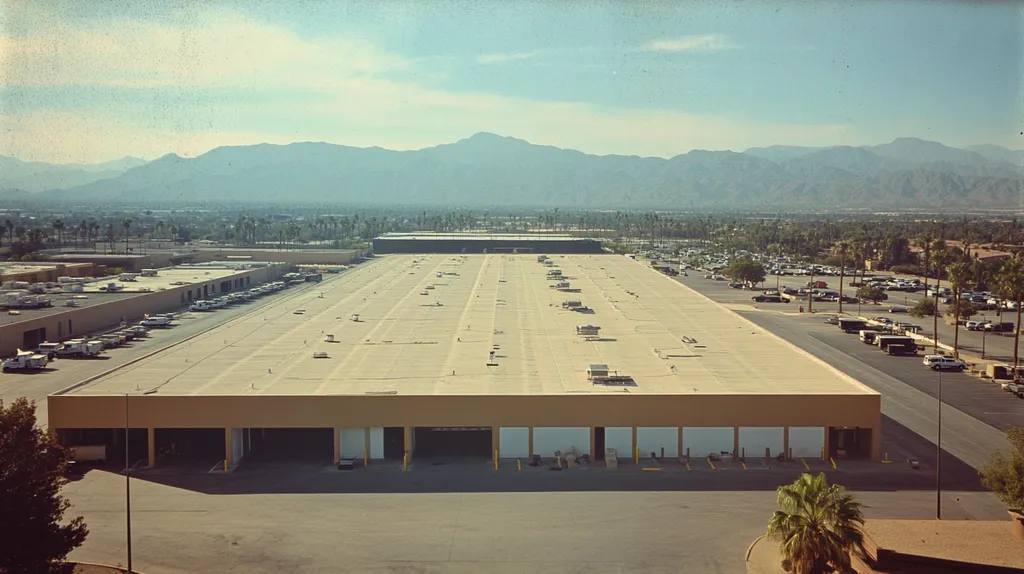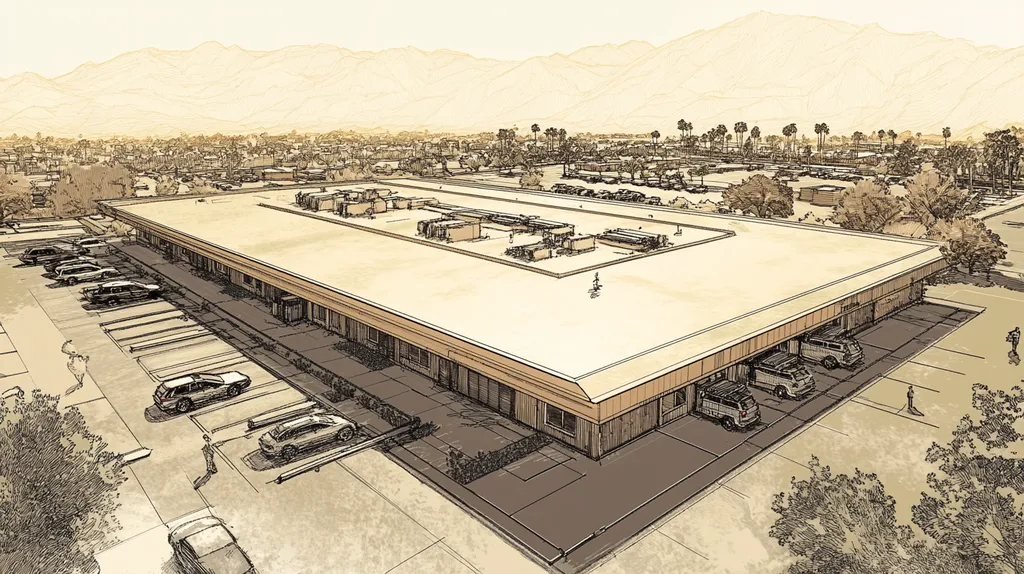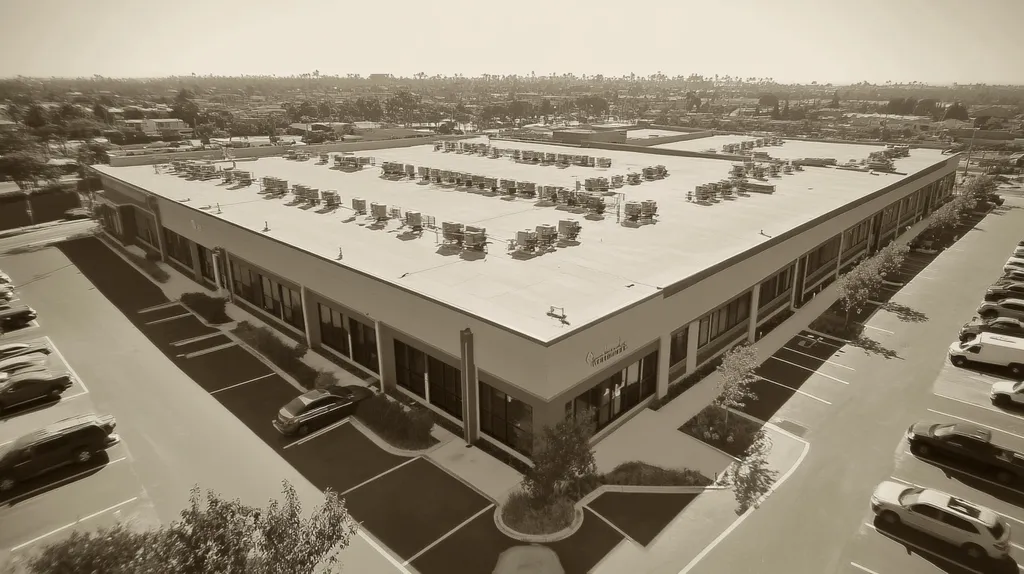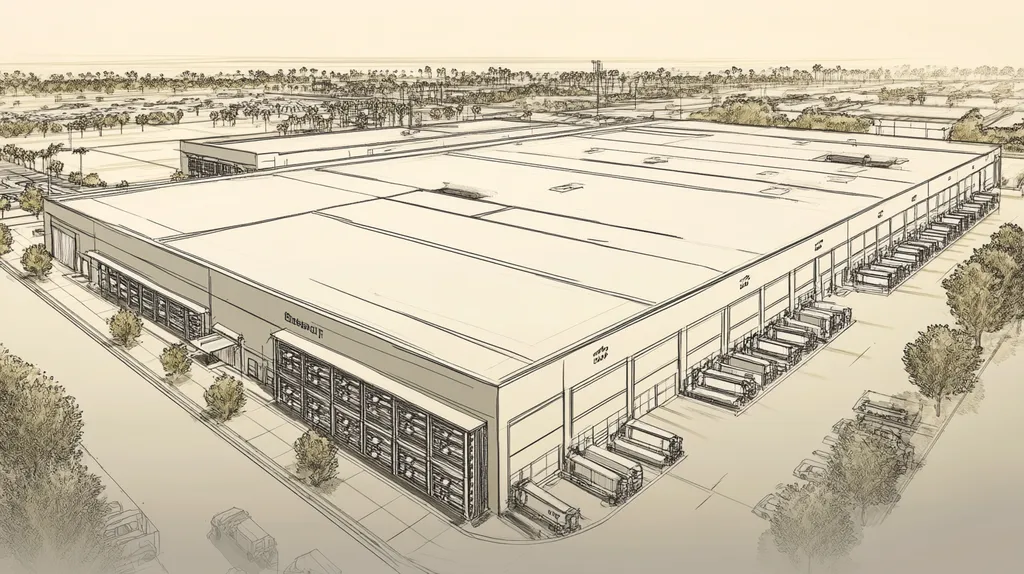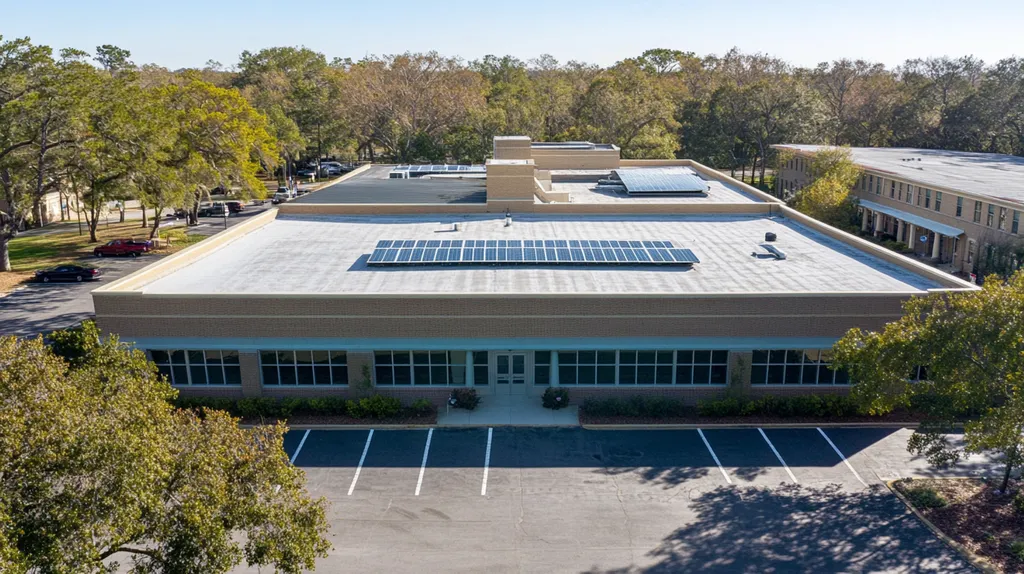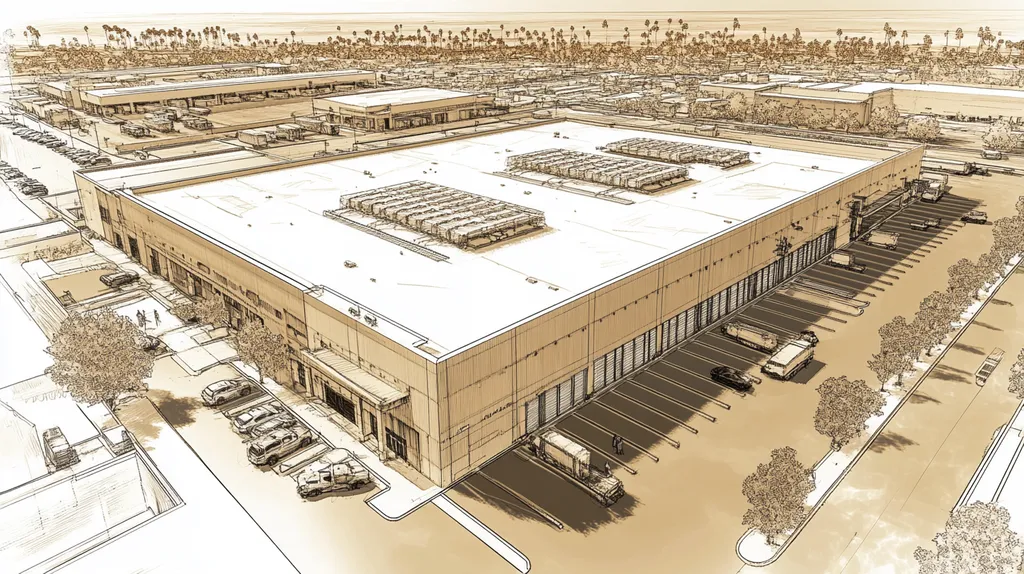When it comes to commercial roof coatings, the stakes couldn’t be higher. Industry studies show that improper coating selection and application leads to premature failures costing property owners an average of $2.40 per square foot in repairs annually.
From reflectivity metrics to installation procedures, understanding key performance indicators is crucial for protecting these significant investments. Yet 65% of facility managers report struggling to effectively evaluate coating success.
This comprehensive guide breaks down the essential metrics and methods for assessing commercial roof coating performance, empowering property professionals to make data-driven decisions that maximize ROI while extending roof lifespans.
SECTION 1: PERFORMANCE FACTORS
Choosing the right commercial roof coating is essential—not just for protecting your roof, but also for boosting energy efficiency. An ineffective coating can lead to steep repair costs and higher utility bills. For instance, reflective roof coatings can trim cooling expenses by up to 20%. Familiarizing oneself with key performance metrics is critical for property owners and facility managers aiming to safeguard their investments and ensure enduring success.
Reflectivity and Emissivity Metrics
Reflectivity and emissivity metrics are essential for evaluating roof coatings. Reflectivity measures how much sunlight a coating deflects, helping to reduce heat absorption significantly. In bustling urban areas, roofs with higher reflectivity can help lower surrounding temperatures, combating the urban heat island effect.
Emissivity indicates how effectively a surface can release absorbed heat. A high emissivity is particularly advantageous in warmer climates, as it keeps buildings cooler. Coatings that excel in both reflectivity and emissivity not only lower roof temperatures but also contribute to a more pleasant environment.
Investing in a roof coating with excellent reflectivity and emissivity can lead to lowered energy expenses and heightened indoor comfort. Accurate ratings empower property managers to make choices that not only enhance their bottom line but advance environmental objectives as well.
It’s crucial to align these metrics with local climate characteristics to achieve the best results. Neglecting this aspect might result in less efficient cooling and increased maintenance burdens.
Key Action Items
Durability and Weather Resistance
When it comes to roof coatings, durability and weather resistance are non-negotiable criteria. Coatings need to endure an array of environmental stressors like UV radiation, rain, snow, and dramatic temperature shifts. For instance, coatings that resist cracking and peeling can significantly prolong a roof’s operational life.
Property owners should evaluate the specific weather patterns their roofs face. High-performance coatings can fend off typical issues like water leaks and mold, protecting the underlying structure of the roof.
Many coatings come with warranties that guarantee their durability in harsh weather, providing peace of mind to property owners. This reduces worries about unexpected failures and can save money in repairs over time.
Conducting regular inspections complements the efficacy of durable coatings, identifying potential wear and tear before they escalate into expensive fixes. A proactive maintenance strategy keeps roofs functional and fully protects the property’s value.
Key Action Items
Energy Efficiency and Thermal Conductivity
Energy efficiency ranks high on the checklist when evaluating roof coatings. A coating’s thermal conductivity affects how well it insulates a building, which can affect overall energy use. High-quality coatings can markedly improve energy performance, leading to reduced heating and cooling demands.
Reflective roof coatings excel in lowering cooling costs while broadening overall energy savings. Data from energy audits reveal that buildings outfitted with energy-efficient coatings can save thousands in utility expenses each year.
Emphasizing energy-efficient coatings can also help comply with regulatory requirements and sustainability objectives. Numerous cities offer incentives for eco-friendly upgrades, presenting extra financial advantages.
In the long run, investing in energy-efficient roof coatings serves not only as a financial boon but also as a contribution to environmental stewardship, appealing to a growing base of eco-aware tenants and customers.
Key Action Items
SECTION 2: FINANCIAL CONSIDERATIONS
Grasping the financial dynamics of commercial roof coatings is crucial for savvy property owners. Many overlook the long-term savings, fixating on initial costs instead. However, high-quality coatings can slash energy expenses by as much as 30%. A holistic evaluation of all costs—from installation to upkeep—enables informed decisions about valuable roofing investments.
Initial Cost vs. Long-Term Savings
While the upfront investment for roof coatings may appear steep, property owners must weigh this against the remarkable long-term savings. For example, reflective coatings can significantly reduce cooling expenses in warmer climates, leading to noticeable annual savings.
A longer-lasting roof lifespan also diminishes the frequency of costly replacements. Choosing durable coatings can lead to recouping the investment over time, as these materials outlast traditional options.
To fully understand total cost of ownership, consider energy savings and maintenance costs over the years. This big-picture approach highlights how a strategic initial expense can yield impressive returns.
Key Action Items
Maintenance and Repair Expenses
Maintenance and repair costs play a vital role in assessing roof coatings. Typically, well-coated roofs require less upkeep compared to conventional roofing systems. This reduction not only cuts direct costs but also minimizes disruptions due to repairs.
For example, certain coatings offer additional waterproofing, which reduces the frequency of leaks and repairs. Streamlined maintenance leads to more predictable budgeting for facilities managers.
Moreover, selecting the right roof coating decreases the likelihood of costly repairs throughout its lifespan. A judicious choice, informed by performance metrics, safeguards against unexpected financial burdens.
Key Action Items
Tax Benefits and Depreciation
Investing in commercial roof coatings can also bring financial perks through tax incentives. Certain energy-efficient coatings may qualify for federal and state tax deductions, providing immediate fiscal relief. These incentives can considerably offset initial installation costs.
Additionally, the durability of high-quality roof coatings enhances potential depreciation benefits. Extending the lifespan of roofing assets allows property owners to amortize costs over a more extended period.
By prioritizing coatings with proven performance records, property managers can optimize tax benefits while safeguarding their assets for the long haul. Understanding these financial nuances encourages informed decision-making, resulting in improved cash flow and property value.
Key Action Items
SECTION 3: COMPLIANCE REQUIREMENTS
Navigating the world of commercial roofing compliance is not merely about ticking boxes; it’s about safeguarding investments and ensuring long-term roof performance. Adhering to ASTM standards and local building codes is essential, as failure to do so can lead to financial headaches and the risk of early roof failures. With over 30% of roofing projects falling short in compliance, it’s imperative for property owners and facilities managers to prioritize understanding these vital requirements.
ASTM and Industry Standards
The American Society for Testing and Materials (ASTM) establishes critical standards for roofing materials and their applications. Meeting these guidelines ensures the quality and performance of roof coatings. For example, ASTM D6083 details the specifications for acrylic roof coatings, addressing key aspects such as adhesion, flexibility, and UV stability.
Ignoring these standards could lead to inferior coatings that falter under pressure, resulting in frustrating leaks and costly damage. Property owners must confirm that their suppliers offer products certified to ASTM standards to protect their financial investments.
Using materials that adhere to these rigorous guidelines not only helps enhance the building’s energy efficiency but also illustrates a commitment to quality and sustainability—key factors for remaining competitive in today’s market. High-quality, compliant materials present a strategic advantage, safeguarding both the roof’s integrity and the overall property value.
Key Action Items
Local Building Codes and Regulations
Every location has specific building codes that govern roofing installations and maintenance, crafted to ensure safety, durability, and energy efficiency. For example, commercial buildings in hurricane-prone regions must adhere to local codes that stipulate wind resistance for roofing materials.
Neglecting compliance with these codes can lead to fines, project delays, or even serious safety hazards for occupants. Property managers should proactively seek guidance from local building authorities or roofing professionals to grasp the specific requirements impacting their projects.
By complying with local regulations, property owners not only bolster structural integrity but can also enhance their property’s resale value. Properties that meet or exceed standards are more appealing to potential buyers, ensuring a strong return on investment. Conducting regular audits of roofing compliance will help in staying ahead of any regulatory updates.
Key Action Items
Environmental Compliance and Sustainability
With the growing emphasis on sustainability, compliance with environmental regulations has become a key factor in roofing decisions. Adhering to these regulations—particularly concerning emissions and waste management—can significantly impact a property’s reputation and operational costs. Many guidelines mandate that roof coatings contain low volatile organic compounds (VOCs) to reduce air pollution.
Achieving green building certifications, such as LEED, rewards properties that meet these sustainability criteria. Not only do these certifications enhance marketability, but they can also attract tenants and investors focused on eco-friendly practices.
Additionally, utilizing compliant, environmentally friendly coatings can yield long-term savings through energy efficiency initiatives that lower operating costs. For instance, reflective roof coatings can dramatically cut cooling energy demands, providing a measurable return on investment.
Pursuing robust environmental compliance positions property owners as trailblazers in sustainability, setting the stage for future growth and evolution in a rapidly changing industry.
Key Action Items
SECTION 4: RISK MANAGEMENT
Effective risk management is paramount for the success of commercial roof coatings. Ignoring potential risks can result in hefty financial losses, extended downtimes, and serious safety hazards. Research shows that property owners who fail to manage their roofs properly may incur maintenance and repair costs up to 60% higher over time. This section explores how to pinpoint potential failure points, mitigate weather-related risks, and ensure the correct installation and application of roof coatings.
Identifying Potential Failure Points
Spotting potential failure points is vital for managing risk in roof coatings. Common challenges include poor substrate preparation, wrong material selection, and unfavorable environmental factors during application. By identifying these issues early, property owners can prevent severe damage down the road.
For example, a coating applied over a dirty or damp surface might not bond well, resulting in early failure. Conducting thorough inspections before and after coating application is crucial for minimizing these risks. Additionally, training facility managers in regular assessment practices is essential for maintaining roof integrity.
Keeping detailed records of repairs and maintenance will help in tracking the roof’s condition over time. This proactive strategy empowers property owners to make informed decisions and utilize resources efficiently.
Key Action Items
Mitigating Weather-Related Risks
Weather significantly influences the lifespan and performance of roof coatings. Extreme temperatures, heavy rainfall, and strong winds can undermine coating effectiveness, leading to higher repair costs and a reduced lifespan. Selecting coatings tailored to local weather conditions is key to mitigating these risks.
For instance, in hotter climates, reflective coatings can alleviate thermal stress. Alternatively, elastomeric coatings offer improved flexibility in regions experiencing freeze-thaw cycles. Understanding regional weather patterns empowers property owners to choose the most appropriate products.
Timing the application is also critical. Avoiding installations during harsh weather or extreme temperatures can prevent potential failures. Establishing a weather monitoring system can assist in scheduling installations for optimal conditions.
Key Action Items
Ensuring Proper Installation and Application
Proper installation and application techniques are essential to the success of roof coatings. If done inadequately, issues like bubbling, cracking, or peeling can arise. Enlisting experienced professionals with a solid track record is crucial for ensuring high-quality installation.
Adhering to manufacturer guidelines is vital. These guidelines outline requirements for surface preparation, application processes, and curing times. Property owners should verify contractor compliance to safeguard the coating’s performance.
Offering regular training and certification for installation teams can lead to superior work quality. This focus on excellence helps mitigate the risk of costly repairs and extends the roof’s lifespan. Additionally, conducting inspections post-application can detect and address any application errors promptly.
Key Action Items
SECTION 5: OPERATIONAL PROCEDURES
Operational procedures play a vital role in the longevity and effectiveness of roof coatings. Proper preparation and application are key to avoiding premature failures that can drain budgets and resources. A staggering 30% of commercial roof coating failures stem from inadequate preparation and application methods. This section outlines crucial steps to take, from preparing surfaces to applying coatings and conducting inspections afterward, ensuring roof performance metrics soar to new heights.
Pre-Application Surface Preparation
A successful roof coating job begins long before paint touches the surface. Meticulous surface preparation is essential for securing optimal adhesion and enhancing the durability of the coating. This involves thoroughly cleaning the roof to eliminate dirt, debris, and old coatings, using methods like power washing or mechanical scrubbing.
Identifying and addressing loose granules, rust, or damaged areas is crucial, as these can undermine the new coating’s performance. Properly inspecting for cracks or blisters ensures that potential issues are resolved before application, saving you from headaches later on.
Checking the moisture content of the substrate is another critical step. Applying coatings to damp surfaces leads to adhesion problems and premature peeling. Using moisture meters helps confirm readiness for application and ensures better results.
Key Action Items
Application Methods and Best Practices
With a clean surface prepped and primed, it’s time for the application to shine! The method selected—whether it’s spraying, rolling, or brushing—should match the type of coating and roof style. Spraying is the go-to for expansive areas, while rolling suits smaller touch-ups perfectly.
Following the manufacturer’s guidelines regarding temperature and humidity is crucial. Coatings applied outside of the recommended conditions may bubble or peel, jeopardizing their effectiveness. Using temperature and humidity monitors ensures optimal application conditions.
Applying multiple thin layers instead of a single thick one can significantly improve durability. This method allows for better drying and stronger bonding. Also, mixing the materials properly is essential for consistent finishes and reliable performance.
Key Action Items
Post-Application Inspection and Testing
Once the coating is applied, a thorough post-application inspection is essential. This step guarantees that the coating meets the expected quality standards. Inspectors should closely assess the evenness of the coating, confirming there are no missed spots or uneven thickness.
Conducting adhesion and flexibility tests is critical for understanding the coating’s performance. Methods like pull-off tests provide tangible metrics on how well the coating has bonded. Regular evaluations will help identify any early signs of complications.
Establishing a routine for periodic inspections ensures ongoing performance monitoring. This proactive approach can ultimately enhance maintenance strategies, leapfrogging operational effectiveness and mitigating long-term costs.
Key Action Items
SECTION 5: OPERATIONAL PROCEDURES
Operational procedures are critical to ensuring that roof coatings deliver their intended benefits, such as extending the roof’s lifespan and cutting maintenance costs. Unfortunately, nearly 30% of commercial roof coating failures are due to inadequate preparation and application methods. This section highlights the essential procedures involved in pre-application surface preparation, application best practices, and post-application inspections to maximize roof performance metrics.
Pre-Application Surface Preparation
Successful roof coatings start with meticulous surface preparation that guarantees optimal adhesion and durability. This step involves thoroughly cleaning the roof to eliminate dirt, debris, and outdated coatings, employing methods like power washing or mechanical scrubbing based on the roof’s condition.
Additionally, attention to loose granules, rust, or other compromises is essential, as they can undermine the new coating’s effectiveness. Inspecting for cracks or blisters helps identify areas needing repair before application, preventing headaches later on.
Moisture content assessment is equally important. Coatings applied to damp surfaces can lead to adhesion issues, making moisture meters a valuable tool for confirming readiness. A detailed examination of seams, penetrations, and terminations should also take place, addressing these critical points through proper sealing and reinforcement.
Key Action Items
Application Methods and Best Practices
With a prepared surface, the focus shifts to effective application techniques. The method chosen—spraying, rolling, or brushing—should align with the coating material and roof type. Spraying is typically best for large areas, while rolling is ideal for smaller sections or touch-ups.
Adhering to the manufacturer’s guidelines regarding temperature and humidity is crucial, as applications outside recommended conditions can lead to bubbling and poor adhesion, jeopardizing coating effectiveness. Monitoring tools help ensure optimal application conditions.
Employing multiple thin coats rather than a single thick application enhances durability, allowing for better drying and bonding. Timing between coats must be strictly followed to optimize roof performance, and ensuring proper material mixing is essential for a consistent and effective finish.
Key Action Items
Post-Application Inspection and Testing
Once the coating is applied, conducting a thorough post-application inspection is crucial to ensuring quality. Inspectors should assess evenness and consistency of the coating, checking for missed spots and variations in thickness during the initial curing weeks.
Testing adhesion and flexibility using industry-standard methods, such as pull-off tests, provides tangible metrics on the coating’s bond integrity. Ongoing performance monitoring is also essential; establishing periodic inspection schedules helps catch issues before they escalate into major problems.
Utilizing insights from these inspections to refine maintenance strategies can greatly enhance operational efficiency. By consistently evaluating performance metrics, property managers can ensure continued roof protection while minimizing long-term costs.
Key Action Items
The Bottom Line
With commercial roof coating failures costing property owners an average of $2.40 per square foot annually, implementing proper performance metrics is no longer optional—it’s essential for survival.
Industry data shows that properties using comprehensive coating evaluation systems reduce maintenance costs by up to 40% while extending roof lifespans by 10-15 years.
Success hinges on three critical factors: selecting coatings based on verified performance metrics, ensuring proper installation through rigorous quality control, and maintaining detailed documentation of all inspections and maintenance.
As environmental regulations tighten and energy costs continue rising, properties that fail to implement these evaluation frameworks risk significant financial exposure and reduced asset values.
The future belongs to those who measure, monitor, and maintain their roof coating investments with data-driven precision.
FREQUENTLY ASKED QUESTIONS
Q. What key performance factors impact my commercial roof coating?
A. Essential factors include reflectivity, emissivity, durability, and weather resistance. A coating’s ability to reflect sunlight helps lower energy costs, while effective emissivity ensures heat release, particularly in warm climates. Additionally, a durable coating resists environmental stressors, extending your roof’s lifespan and maintaining operational efficiency.
Q. How do financial considerations affect my industrial roof coatings?
A. It’s crucial to analyze initial costs against long-term savings. While the upfront investment for quality coatings might be higher, the savings in energy expenses and reduced maintenance can offset these costs. Evaluating total cost of ownership over time will help you make a more informed investment decision.
Q. What compliance requirements should I consider for my commercial roof?
A. Adhering to ASTM standards and local building codes is essential to ensure compliance. These regulations help maintain safety, energy efficiency, and performance. Ensure your materials are certified and meet specific regional requirements to prevent legal issues and protect your investment.
Q. How can I manage risks associated with my commercial roof coatings?
A. Risk management involves identifying potential failure points, such as improper substrate preparation and environmental factors. Regular inspections and training for facility managers can prevent costly repairs and enhance roof longevity. Address weather-related risks by choosing suitable coatings for your climate and scheduling installations wisely.
Q. What operational procedures should I follow for roof coating systems?
A. Proper operational procedures include meticulous pre-application surface preparation, adherence to application best practices, and conducting post-application inspections. Cleaning the surface, applying multiple thin coats, and regularly inspecting the finished product will maximize the performance of your roof coatings.
Q. How do I ensure durability in my commercial roof coatings?
A. Selecting the right coating type and verifying its durability ratings against local weather conditions are vital. Regular inspections and proactive maintenance will also ensure that early wear and tear is addressed, prolonging the life of the roof and avoiding costly repairs down the line.
Q. What are the benefits of reflective coatings for my roof?
A. Reflective coatings significantly lower heat absorption, enhancing energy efficiency and reducing cooling costs. This makes them particularly beneficial in warmer climates. Additionally, they can extend the roof’s life by minimizing thermal stress and contribute to a more comfortable indoor environment for occupants.

